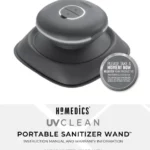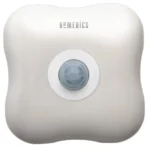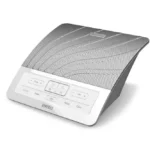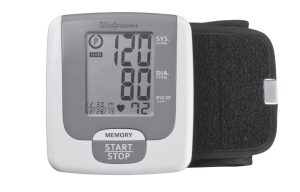

AUTOMATIC WRIST
Blood Pressure Monitor

WGNBPW-710
Ver. A
IMPORTANT PRODUCT NOTICES AND SAFETY INSTRUCTIONS
When using your blood pressure monitor, basic precautions
should always be followed. Please read and follow all
instructions and warnings before using this product. Save these
instructions for future reference.
- Please note that this is a home healthcare product only and it is not intended to serve as a substitute for the advice of a physician or medical professional.
- This device uses the oscillometric method to measure systolic and diastolic blood pressure, as well as heart rate.
- Do not use this device for the diagnosis or treatment of any health problem or disease. Measurement results are for reference only. Consult a healthcare professional for interpretation of blood pressure measurements. Contact your physician if you have or suspect any medical problem. Do not change your medications without the advice of your physician or healthcare professional.
- This product is not suitable for people with arrhythmias. This device may have difficulty determining the proper blood pressure for pregnant women, individuals with an irregular heartbeat, diabetes, poor circulation of blood, kidney problems or for users who have suffered from a stroke.
- Excessive use may result in blood flow interference, which is likely to cause uncomfortable sensations, such as partial subcutaneous hemorrhage, or temporary numbness to your wrist. In general, these symptoms should not last long. However, if you do not recover in time, please seek advice from a medical professional.
- Consult your physician before measuring blood pressure at the wrist if you have any of the following conditions: Severe hypertension, severe diabetes, severe arteriosclerosis, severe kidney disease, or vascular disease that may compromise circulation.
- The pulse display is not suitable for checking the frequency of heart pacemakers.
- Electromagnetic interference: The device contains sensitive electronic components. Avoid strong electrical or electromagnetic fields in the direct vicinity of the device (e.g. mobile telephones, microwave ovens). These may lead to temporary impairment of measurement accuracy.
- Consider the electromagnetic compatibility of the device (ex. power disturbance, radio frequency interference etc.) Please use this device indoors only.
- Use blood pressure monitor only for its intended use.
- Do not wrap the cuff around body parts other than your wrist.
- Not for use by or on persons under the age of 18.
- Do not use this device on infants, children, or those who cannot express their own intention.
- Use only 1.5V “AAA” alkaline batteries for the power supply. Blood pressure measurements determined with this device are equivalent to those obtained by a trained observer using the cuff/stethoscope auscultatory method, within the limits prescribed by the American National Standard, Manual, electronic, or automated sphygmomanometers.
ABOUT BLOOD PRESSURE
What is Blood Pressure?
Blood pressure is the pressure exerted on the artery walls while blood flows through the arteries. The pressure measured when the heart contracts and sends blood out of the heart is systolic (highest) blood pressure. The pressure measured when the heart dilates with blood flowing back into the heart is called diastolic (lowest) blood pressure.
Why Measure Your Blood Pressure?
Among today’s various health problems, those associated with high blood pressure are very common. High blood pressure dangerously correlates with cardiovascular diseases. Therefore, blood pressure monitoring is important for identifying those at risk.
BLOOD PRESSURE STANDARD
The table on page 6 contains defined levels for hypertension that are publicly available from the National Heart Lung and Blood Institute at the U.S. National Institutes of Health (NIH) (http://www.nhlbi.nih.gov/health/dci/Diseases/Hbp/HBP_WhatIs.html). Users can compare their own blood pressure readings against these defined levels to determine if they may be potentially at increased risk.
This table is applicable to most adults aged 18 and older.
Blood pressure tends to go up and down, even in people who normally don’t have high readings. If your numbers stay above the “normal” range most of the time, you may be at increased risk and should consult your physician.

Although one can easily find where their own blood pressure readings fall on this table, this monitor comes equipped with a Risk Category Index that automatically compares each reading to the defined levels and provides a helpful cue if your reading falls into one of the stages that could potentially indicate increased risk. See page 19 for more information on this feature.
Please note that cues provided by this monitor are only intended to assist you in using this table. The table and cues are only provided for convenience to help you understand your non-invasive blood pressure reading as it relates to the NIH information. They are not a substitute for a medical examination by your physician. It is important for you to consult with your physician regularly. Your physician will tell you your normal blood pressure range as well as the point at which you may actually be considered to be at risk.
HOW THIS BLOOD PRESSURE MONITOR WORKS
This monitor uses innovative technology to detect your blood pressure. This technology enables the monitor to automatically inflate and deflate at the appropriate level for each individual. With one touch of a button, the cuff will automatically inflate to block the blood flow through your artery. Next, the deflation process starts.
Please note that any muscle movement during inflation or deflation will cause measurement errors. When the measurement is complete, the monitor will display your systolic pressure, diastolic pressure, and pulse readings.
The monitor automatically finds where your measurement results fall on the NIH’s National Heart Lung and Blood Institute’s table and provides a cue if your reading falls into one of the stages that could potentially indicate increased risk. See page 19 for more information on this feature.
The appearance of the icon indicates that a pulse irregularity consistent with an irregular heartbeat was detected during measurement. Refer to page 20 for more information on the Irregular Heartbeat Detector.
NAME/FUNCTION OF EACH PART
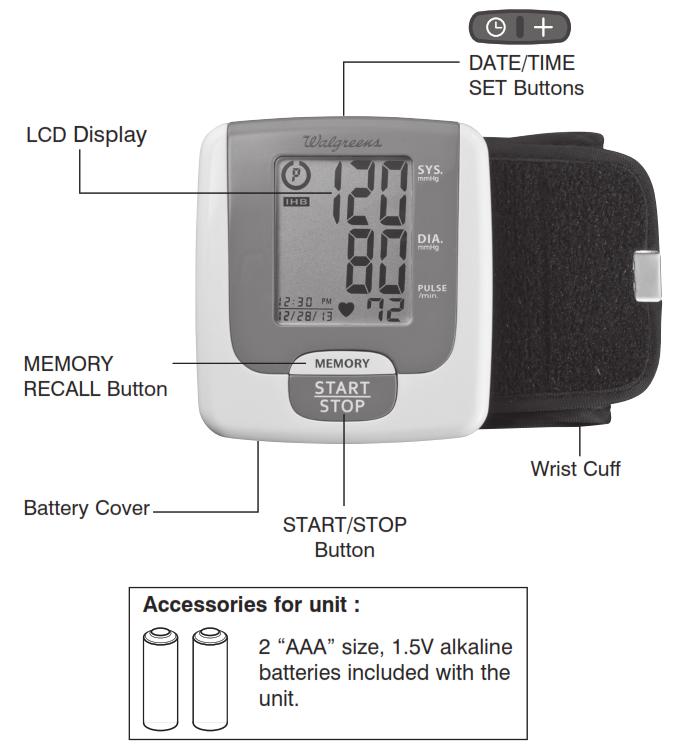
DISPLAY EXPLANATIONS
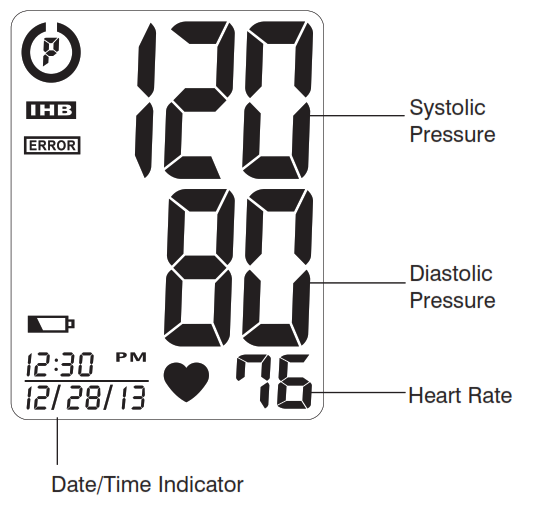
Display Symbols:

If and any of the following letters and numbers appear in the area that systolic pressure should be displayed, an error has occurred with your reading. See the Troubleshooting section of this manual for more information.
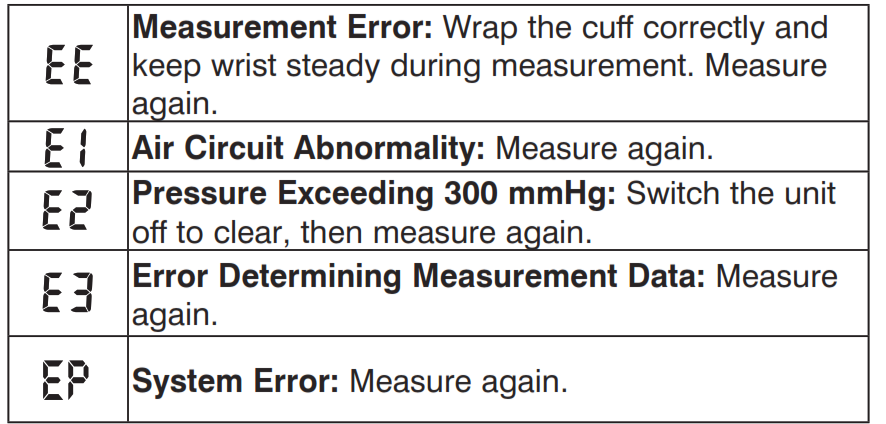
INSTALLING BATTERIES
1. The battery cover is located along the side of the monitor. Remove the battery cover by pressing down and pulling away from the monitor.

2. Install batteries according to the polarity indications inside the compartment (as shown in figure 2). Battery Type: 2 Alkaline LR03 “AAA” size
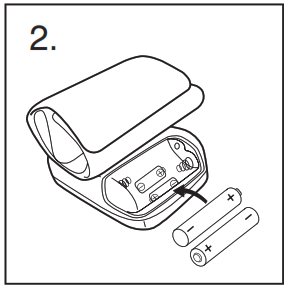
3. Insert the other battery, according to the polarity indications inside the compartment (as shown in figure 3).
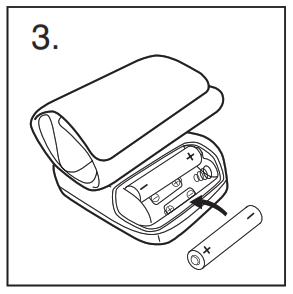
4. Replace the cover by inserting it back into place.
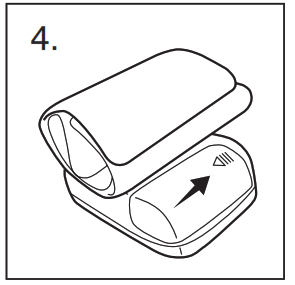
Replace the batteries if:
• The weak battery symbol appears on the display.
• Nothing appears on the display when the power is switched on.
As the supplied batteries are for test only, they may be discharged earlier than batteries you buy in stores. Replace all batteries at one time (as a simultaneous set). Use only 1.5V “AAA” alkaline batteries. Remove batteries when the unit is not in use for extended periods of time. The date and time will need to be reset if batteries are removed or replaced. Clean contacts on the battery and in the battery compartment with a soft dry cloth each time you install batteries.
Note:
Batteries are hazardous waste. Do not dispose of them together with the household garbage.
DATE and TIME SET PROCEDURE
1. To adjust the date and time, press the DATE/TIME SET button
2. The display will show a blinking number showing the HOUR. Change the HOUR by pressing the button. Each press will increase the number by one in a cycling manner. Press the DATE/TIME SET button 
3. Change the MINUTE, MONTH, DAY, and YEAR as described in Step 2 above, using the button to change the numbers and the DATE/TIME SET button 
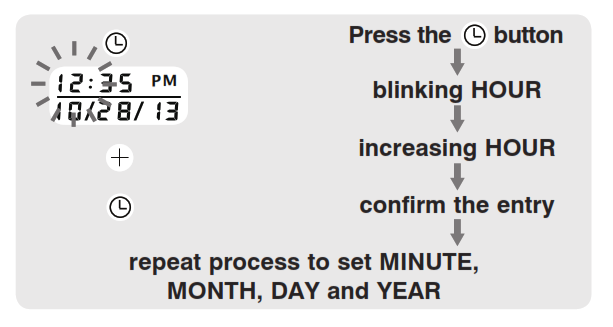
APPLYING THE CUFF
1. Remove all watches, wrist jewelry, etc. prior to attaching the wrist monitor. Clothing sleeves should be rolled up and the cuff should be wrapped around bare skin for correct measurements.
2. Apply the cuff to the left wrist with the palm facing up as shown in Fig. A.

3. Make sure the edge of the cuff is about 1/4”~1/2” (1 cm) from the palm as shown in Fig. B.
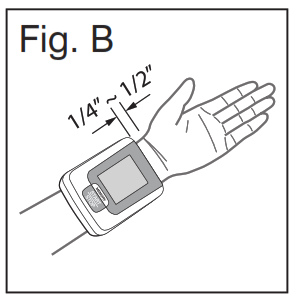
4. In order to ensure accurate measurements, fasten the hook and loop strap securely around your wrist so there is no extra space between the cuff and the wrist. If the cuff is not wrapped tight enough, the measurement values will not be accurate.
5. If your physician has diagnosed you with poor circulation in your left arm, place the cuff around your right wrist as shown in Fig. C.
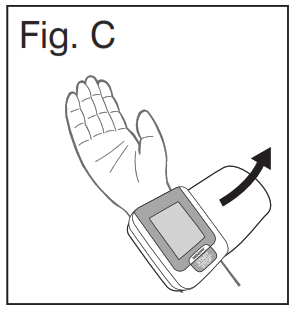
Note:
• This device should not be used when your wrist is wounded or injured.
• If it is not possible to use the cuff on your left wrist, it can also be used on your right wrist. However, all measurements should be made using the same wrist.
CORRECT MEASUREMENT POSTURE
1. Place your elbow on a table so that the cuff is at the same level as your heart as shown in Fig. A. Relax your entire body, especially between your elbow and fingers.
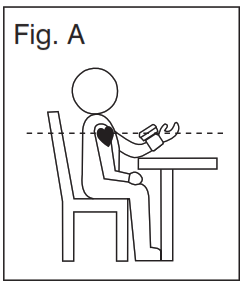
Note: Your heart is located slightly below your armpit.
2. If the cuff is not at the same level as your heart or if you cannot keep your arm completely still throughout the reading, use a soft object such as a folded towel to support your wrist as shown in Fig. B.
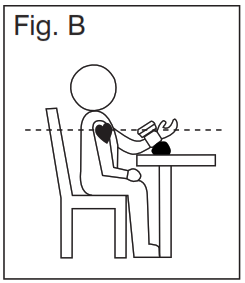
3. Turn your palm upwards.
4. Sit upright in a chair, and take 5-6 deep breaths.
Avoid leaning back while the measurement is being taken as shown in Fig. C.
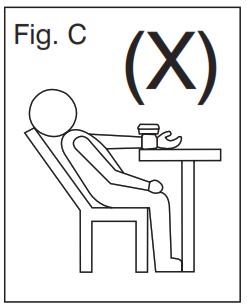
MEASUREMENT PROCEDURE
Important Notes:
- Position the monitor at the same level as your heart during measurement to ensure accurate readings.
- Blood pressure changes with every heartbeat and is in constant fluctuation throughout the day.
- Blood pressure measurement can be affected by the position of the user, his or her physiologic condition, and other factors. For greatest accuracy, wait 1 hour after exercising, bathing, eating, drinking beverages with alcohol or caffeine, or smoking to measure blood pressure.
- Before a measurement, it is suggested that you sit quietly for 15 minutes as measurements taken during a relaxed state will have greater accuracy. You should not be physically tired or exhausted while taking measurements.
- During the measurement, do not talk or move your arm or hand muscles.
- See page 22 for additional notes regarding your blood pressure measurement.
If you are using this blood pressure monitor for the first time, please remove the protective film from the screen.
1. With the cuff wrapped around your wrist, press the START/STOP button. Do not inflate the cuff unless it is wrapped around your wrist. All digits will light up, checking the display functions. The checking procedure will be completed after about 3 seconds.
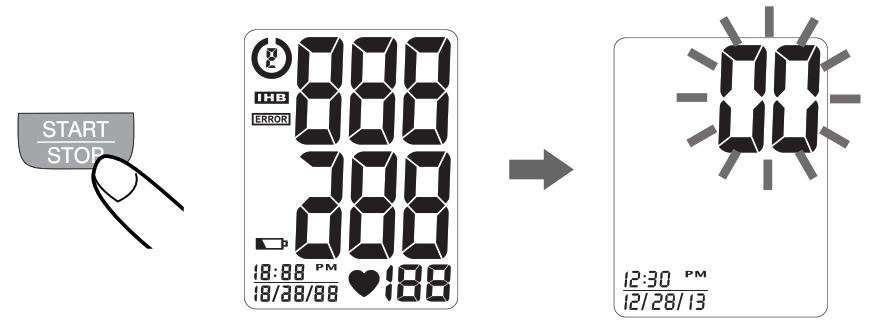
2. After all symbols disappear, the display will show “00”. The monitor is “Ready to Measure” and will automatically inflate the cuff to begin measurement. The cuff will then begin deflating as measurement continues.
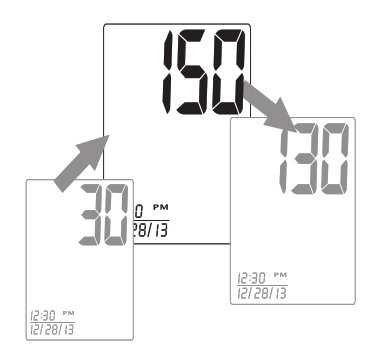
Note:
The monitor will re-inflate automatically if the system detects that your body requires more pressure for measurement.
3. When the measurement is completed, the cuff will deflate entirely and systolic pressure, diastolic pressure, and pulse will be shown simultaneously on the LCD screen. The measurement is then automatically stored in memory.
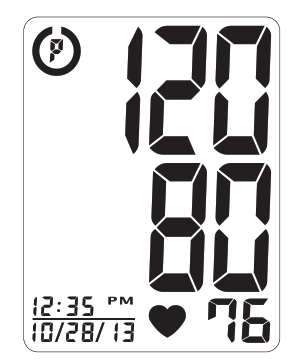
Note:
- This monitor automatically turns off approximately 1 minute after the last operation. You may also press the START/STOP button to turn the unit off.
- To interrupt the measurement, you may press the START/STOP button (recommended), the MEMORY button, or DATE/TIME SET (

RISK CATEGORY INDEX
This monitor comes equipped with a Risk Category Index that automatically compares each reading to defined levels established by the U.S. National Institutes of Health’s (NIH) National Heart Lung and Blood Institute as described earlier in this manual, and provides a helpful cue if your reading falls into one of the stages that could potentially indicate increased risk. No cue is given if the reading falls in the normal range as defined by NIH. Please note that cues provided by this monitor are only intended to assist you in using this table. The table and cues are only provided for convenience to help you understand your non-invasive blood pressure reading as it relates to the NIH information. They are not a substitute for a medical examination by your physician. It is important for you to consult with your physician regularly. Your physician will tell you your normal blood pressure range as well as the point at which you may actually be considered to be at risk.

IRREGULAR HEARTBEAT DETECTOR (IHB)
The appearance of the icon indicates that a pulse irregularity consistent with an irregular heartbeat was detected during measurement. Usually this is not a cause for concern. However, if the symbol appears often, we recommend you seek medical advice. Please note that the device does not replace a cardiac examination, but serves to detect pulse irregularities at an early stage.
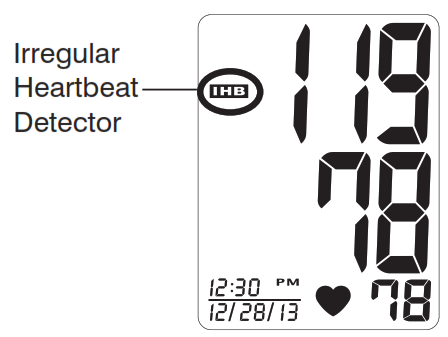
Movement, shaking, or talking during the measurement can result in pulse irregularities that may cause the appearance of this icon. Therefore, it is of great importance to not move or talk during measurement.
To determine the presence of an irregular heartbeat, the average of the heartbeat intervals is calculated with the first 3 normal effective heartbeat values. It is important to note that the average is not a strict mathematical averaging of all recorded intervals. At least 3 beats with a 25% or greater difference from the average heartbeat interval will generate the icon on the screen.
IMPORTANT INFORMATION:
This blood pressure monitor is not designed for use by people with arrhythmias nor for diagnosing or treating an arrhythmia problem. As a safeguard, we recommend that if you have arrhythmias such as atrial or ventricular premature beats and atrial fibrillation or any other special conditions you should check with your physician before using your blood pressure monitor.
RECALLING VALUES FROM MEMORY
1. Press the MEMORY button to access the memory.

2. Every new press of the MEMORY button will recall a previous reading. The latest reading will be recalled first.
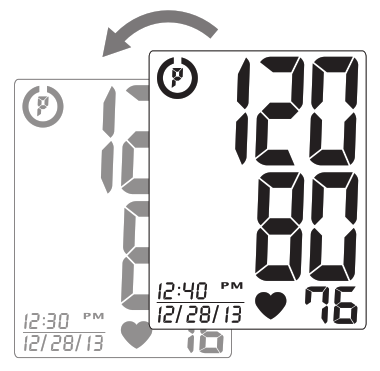
CLEARING VALUES FROM MEMORY
Press and hold the 
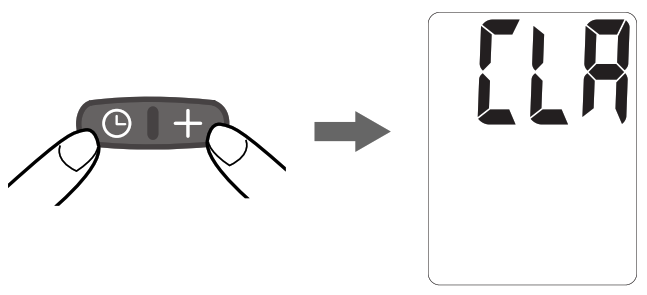
IMPORTANT NOTES REGARDING YOUR BLOOD PRESSURE MEASUREMENT
- Take your reading in a comfortable environment as measurements can be affected by hot or cold temperatures. Take your blood pressure at normal body temperature.
- Do not move or talk during measurement as this can elevate readings.
- Do not move or cross legs during measurement. Keep feet flat on the floor.
- Do not touch the cuff or monitor during the measurement procedure.
- It is suggested that you take your measurements at the same time each day and use the same wrist for consistency.
- Users should wait a minimum of 5 minutes before taking additional measurements. More time may be necessary depending upon your physiology.
- The measurement results that users receive are for reference only. If users have any blood pressure concerns, please consult a physician.
- Once inflation reaches 300 mmHg, the unit will deflate automatically for safety reasons.
- This product is not suitable for people with arrhythmias.
- This device may have difficulty determining the proper blood pressure for pregnant women and for users with an irregular heartbeat, diabetes, poor circulation of blood, kidney problems, or for users who have suffered a stroke.
CARE, MAINTENANCE and CLEANING
- Clean the blood pressure monitor body and cuff carefully with a slightly damp, soft cloth. Do not press. Do not wash cuff or use chemical cleaner on it. Never use thinner, alcohol or petrol (gasoline) as a cleaner.
- Leaky batteries can damage the unit. Remove the batteries when the unit will not be used for a long time.
- Follow local ordinances and recycling instructions regarding disposal or recycling of the device and device components, including batteries.
- If the unit is stored near freezing, allow it to acclimate to room temperature before use.
- This blood pressure monitor is not field serviceable. You should not use any tool to open the device nor should you attempt to adjust anything inside the device. If you have any problems with this device, please contact HoMedics Consumer Relations (contact information on warranty page).
- Do not immerse the unit in water as this will result in damage to the unit.
- Do not subject the monitor or cuff to extreme temperatures, humidity, moisture, or direct sunlight. Protect from dust.
- Do not fold the cuff tightly.
- Do not disassemble the monitor or cuff. If in need of repair, refer to the warranty section of this manual.
- Do not subject the monitor to extreme shocks (do not drop on the floor).
- Do not inflate the cuff unless wrapped around the wrist.
- Do not wrap the cuff around body parts other than your wrist.
- Do not drop or insert any object into any opening.
- This monitor may not meet its performance specifications if stored or used outside of these temperature and humidity ranges:
- Storage/Transportation Environment
Temperature: -13°F~158°F (-25°C~70°C)
Humidity: Less than 93% RH - Operation Environment
Temperature: 41°F~104°F (5°C ~40°C)
Humidity: 15 ~ 93% RH
POTENTIAL FOR ELECTROMAGNETIC INTERFERENCE
To avoid inaccurate results caused by electromagnetic interference between electrical and electronic equipment, do not use the device near a cell phone or microwave oven. For most wireless communication devices, it is recommended to maintain a distance of 10.8 feet (3.3m) in order to avoid electromagnetic interference.
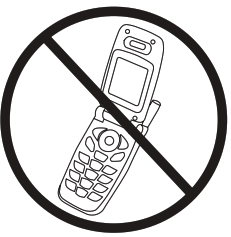
This device complies with Part 15 of the FCC Rules. Operation is subject to the following two conditions: (1) this device may not cause harmful interference, and (2) this device must accept any interference received, including interference that may cause undesired operation.
NOTE: The manufacturer is not responsible for any radio or TV interference caused by unauthorized modifications to this equipment. Such modifications could void the user authority to operate the equipment.
NOTE: This equipment has been tested and found to comply with the limits for a Class B digital device, pursuant to Part 15 of the FCC Rules. These limits are designed to provide reasonable protection against harmful interference in a residential installation. This equipment generates, uses and can radiate radio frequency energy and, if not installed and used in accordance with the instructions, may cause harmful interference to radio communications. However, there is no guarantee that interference will not occur in a particular installation. If this equipment does cause harmful interference to radio or television reception, which can be determined by turning the equipment off and on, the user is encouraged to try to correct the interference by one or more of the following measures:
- Reorient or relocate the receiving antenna.
- Increase the separation between the equipment and receiver.
- Connect the equipment into an outlet on a circuit different from that to which the receiver is connected.
- Consult the dealer or an experienced radio/TV technician for help.
ELECTROMAGNETIC COMPATIBILITY (EMC)
• Guidance and manufacturer’s declaration – electromagnetic emissions
The device is intended for use in the electromagnetic environments listed below, and should only be used in such environments:

• Guidance and manufacturer’s declaration – electromagnetic immunity
The device is intended for use in the electromagnetic environments listed below, and should only be used in such environments:

• Recommended separation distances between portable and mobile RF communication equipment and the device.
The device is intended for use in an electromagnetic environment where radiated RF disturbances are under control. Users can help prevent electromagnetic interference by keeping the device at a minimum distance from portable and mobile RF communications equipment (transmitters). The below table details the maximum output power of the transmitter:

For transmitters rated at a maximum output power not listed above, the recommended separation distance d in meters (m) can be estimated using the equation applicable to the frequency of the transmitter, where P is the maximum output power rating of the transmitter in watts (W) according to the transmitter manufacturer.
NOTE 1 At 80 MHz and 800 MHz, the separation distance for the higher frequency range applies.
NOTE 2 These guidelines may not apply in all situations. Electromagnetic propagation is affected by absorption and reflection from structures, objects, and people.
• Guidance and manufacturer’s declaration – electromagnetic immunity
The device is intended for use in the electromagnetic environments listed below, and should only be used in such environments:
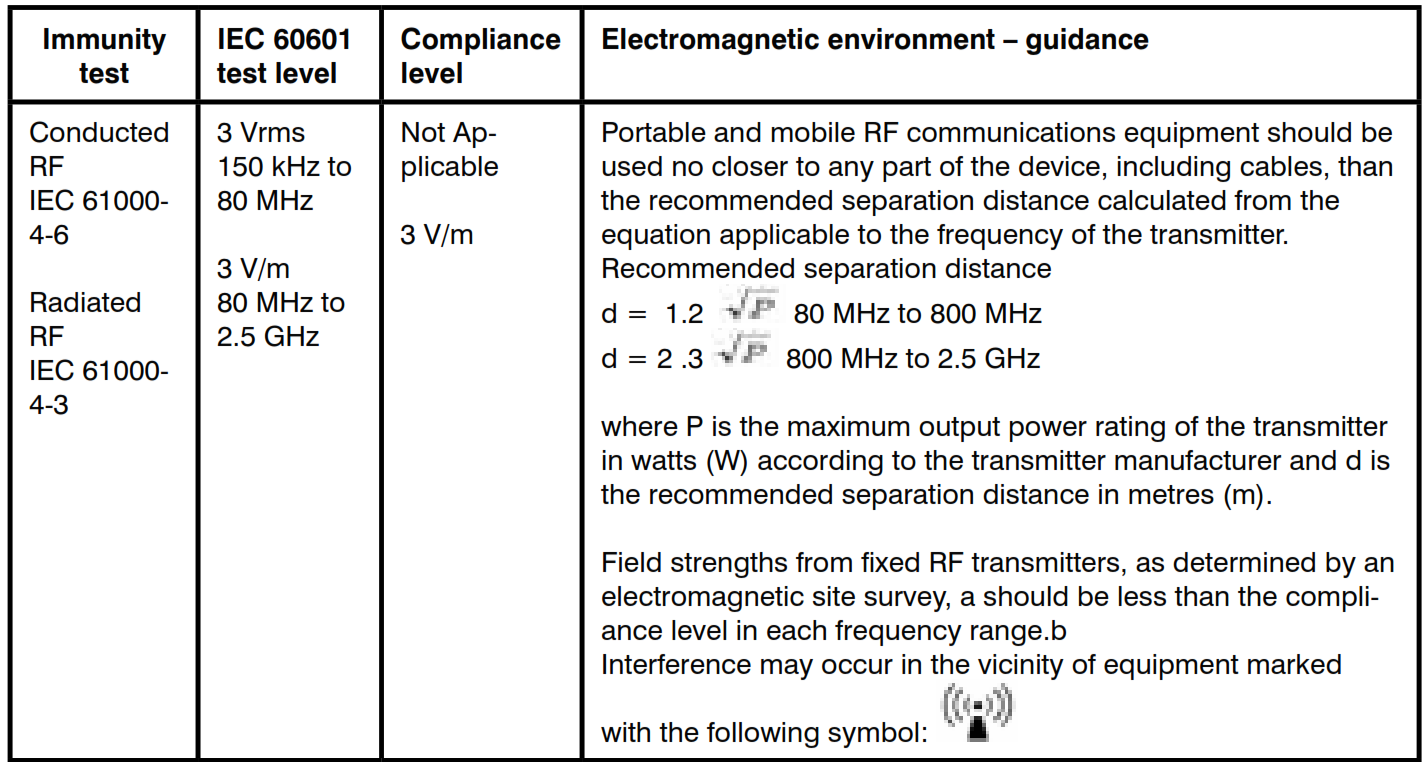
NOTE 1 At 80 MHz and 800 MHz, the higher frequency range applies.
NOTE 2 These guidelines may not apply in all situations. Electromagnetic propagation is affected by absorption and reflection from structures, objects, and people.
a Field strengths from fixed transmitters, such as base stations for radio (cellular/cordless) telephones and land mobile radios, amateur radio, AM and FM radio broadcast, and TV broadcast cannot be predicted theoretically with accuracy. To assess the electromagnetic environment due to fixed RF transmitters, an electromagnetic site survey should be considered. If the measured field strength in the location in which the device is used exceeds the applicable RF compliance level above, the device should be observed to verify normal operation. If abnormal performance is observed, additional measures may be necessary, such as reorienting or relocating the device.
b Over the frequency range 150 kHz to 80 MHz, field strengths should be less than 3 V/m.
TROUBLESHOOTING
If any abnormality arises during use, please check the following points:
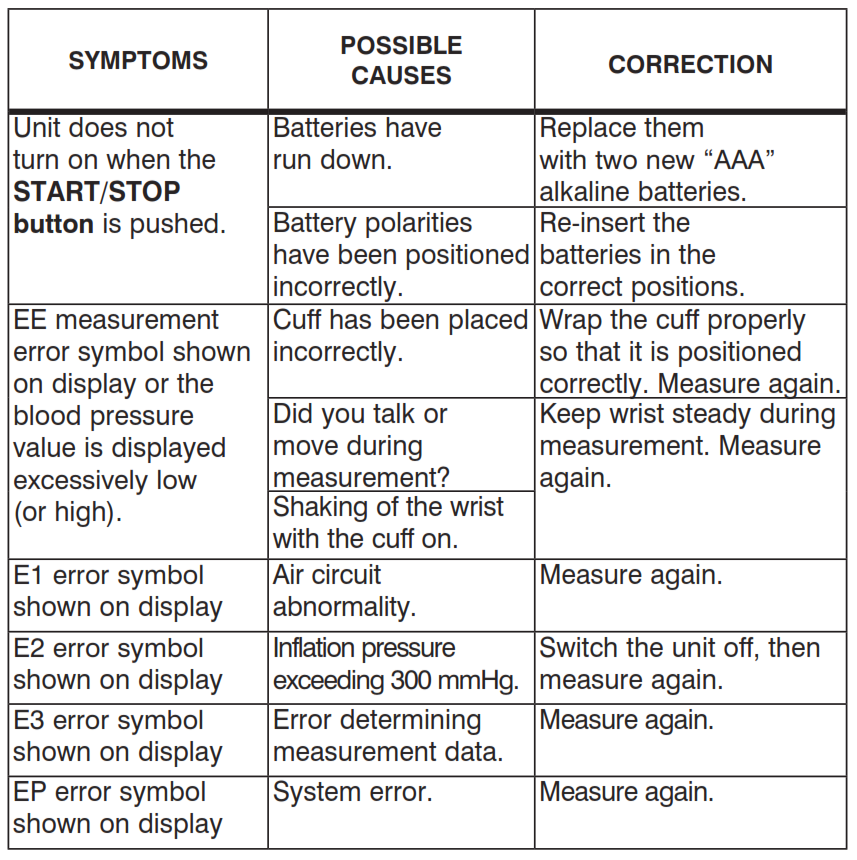
Note: If the unit still does not work, contact HoMedics Consumer Relations. Under no circumstance should you disassemble or attempt to repair the unit by yourself? Contact information for HoMedics Consumer Relations Department can be found on the warranty page.
SPECIFICATIONS
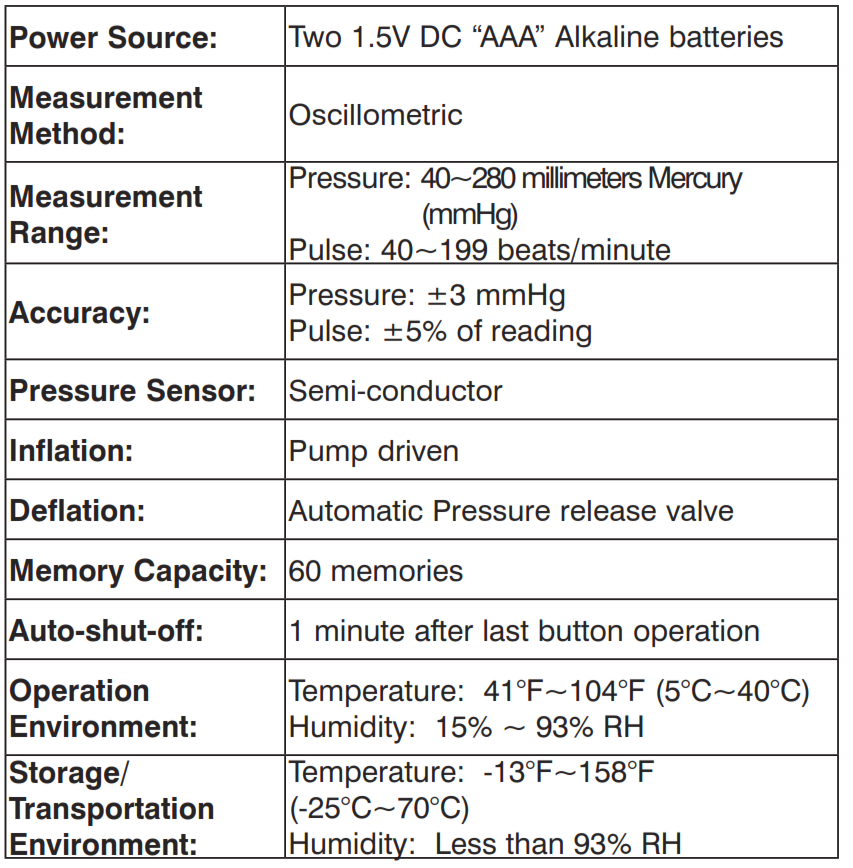

Note: These specifications are subject to change without notice.
LIMITED FIVE YEAR WARRANTY
HoMedics sells its products with the intent that they are free of defects in manufacture and workmanship for a period of five years from the date of original purchase, except as noted below. HoMedics warrants that its products will be free of defects in material and workmanship under normal use and service. This blood pressure monitor meets the simulated measurement cycles test requirement per EN1060-3, part 8.10. This warranty extends only to consumers and does not extend to Retailers.
To obtain warranty service on your HoMedics product, contact a Consumer Relations Representative by telephone at 1-800-466-3342 for assistance. Please make sure to have the model number of the product available.
HoMedics does not authorize anyone, including, but not limited to, Retailers, the subsequent consumer purchaser of the product from a Retailer or remote purchasers, to obligate HoMedics in any way beyond the terms set forth herein. This warranty does not cover damage caused by misuse or abuse; accident; the attachment of any unauthorized accessory; alteration to the product; improper installation; unauthorized repairs or modifications; improper use of electrical/power supply; loss of power; dropped product; malfunction or damage of an operating part from failure to provide manufacturers recommended maintenance; transportation damage; theft; neglect; vandalism; or environmental conditions; loss of use during the period the product is at a repair facility or otherwise awaiting parts or repair; or any other conditions whatsoever that are beyond the control of HoMedics.
This warranty is effective only if the product is purchased and operated in the country in which the product is purchased. A product that requires modifications or adoption to enable it to operate in any other country than the country for which it was designed, manufactured, approved, and/or authorized, or repair of products damaged by these modifications is not covered under this warranty.
THE WARRANTY PROVIDED HEREIN SHALL BE THE SOLE AND EXCLUSIVE WARRANTY. THERE SHALL BE NO OTHER WARRANTIES EXPRESS OR IMPLIED INCLUDING ANY IMPLIED WARRANTY OF MERCHANTABILITY OR FITNESS OR ANY OTHER OBLIGATION ON THE PART OF THE COMPANY WITH RESPECT TO PRODUCTS COVERED BY THIS WARRANTY. HOMEDICS SHALL HAVE NO LIABILITY FOR ANY INCIDENTAL, CONSEQUENTIAL OR SPECIAL DAMAGES. IN NO EVENT SHALL THIS WARRANTY REQUIRE MORE THAN THE REPAIR OR REPLACEMENT OF ANY PART OR PARTS WHICH ARE FOUND TO BE DEFECTIVE WITHIN THE EFFECTIVE PERIOD OF THE WARRANTY. NO REFUNDS WILL BE GIVEN. IF REPLACEMENT PARTS FOR DEFECTIVE MATERIALS ARE NOT AVAILABLE, HOMEDICS RESERVES THE RIGHT TO MAKE PRODUCT SUBSTITUTIONS IN LIEU OF REPAIR OR REPLACEMENT.
This warranty does not extend to the purchase of opened, used, repaired, repackaged, and/or resealed products, including but not limited to the sale of such products on Internet auction sites and/or sales of such products by surplus or bulk resellers. Any and all warranties or guarantees shall immediately cease and terminate as to any products or parts thereof which are repaired, replaced, altered, or modified, without the prior express and written consent of HoMedics.
This warranty provides you with specific legal rights. You may have additional rights that may vary from state to state. Because of individual state regulations, some of the above limitations and exclusions may not apply to you.

Made exclusively for For service or repair, do not return this unit to the retailer. Contact HoMedics Consumer Relations at:
Email: [email protected]
Phone: 1-800-466-3342
Business Hours: 8:30 am-7 pm ET
Monday-Friday
Distributed by

HoMedics, LLC
3000 Pontiac Trail
Commerce
Township, MI
48390
Printed in China
HoMedics® is a registered trademark of HoMedics, LLC.
© 2012-2013 HoMedics, LLC. All rights reserved.
IB-WGNBPW710A
P/N: 323102378 VER. 001
